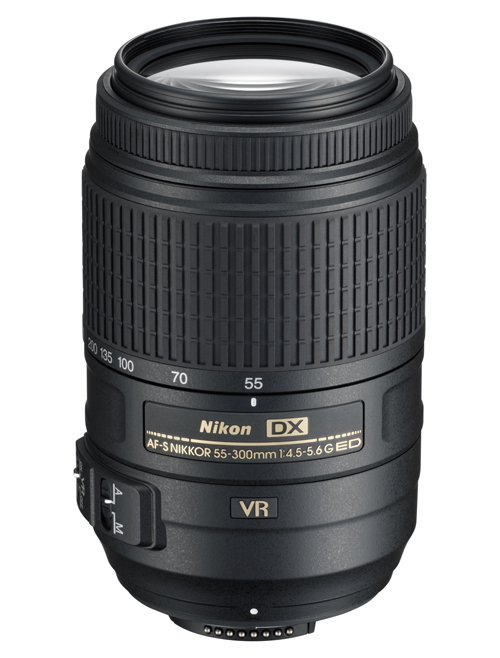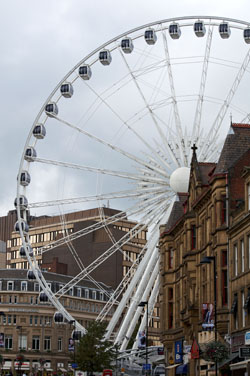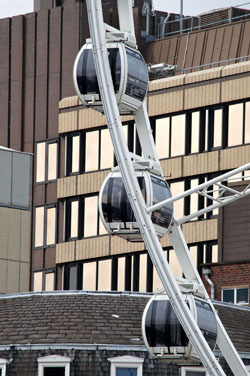Nikon AF-S DX Nikkor 55-300mm f/4.5-5.6G ED VR
| Click on the thumbnails for a high resolution image |
 |
| Gary Wolstenholme takes a look at Nikon's latest telephoto offering for DX format cameras. |
Until the introduction of this lens, Nikon camera users requiring a lens that covers focal lengths up to 300mm to complement their existing kit lens had a compromise on their hands. Either they could choose a lens covering the popular 70-300mm range designed to cover a full frame sensor, but this would leave a gap between 55mm and 70mm, or they could purchase a superzoom lens covering up to 300mm, but this would often result in a slower maximum aperture at 300mm and compromised optical quality.
This new optic from Nikon costs around £370 and sports a Vibration Reduction system that promises to allow shots to be taken at shutter speeds up to four stops slower than without, a silent focusing motor and ED glass elements to help reduce the effects of colour fringing, which is often associated with telephoto lenses.
Alternatives include Nikon's 70-300mm, which also includes Vibration Reduction and a silent focusing motor, but costs around £415 and will leave a gap in focal lengths if being bought to compliment an 18-55mm lens. If you can live without the 300mm focal length, but not with the gap, then Nikon's 55-200mm AF-S VR may fit the bill. It is also a fair bit cheaper at around £240.
No third party manufacturer currently produces a lens covering this range on Nikon cameras, so in this scope it is quite unique.
Nikon AF-S DX Nikkor 55-300mm f/4.5-5.6G ED VR: Handling and features
The build quality of this optic is typical of Nikon's mid to higher end consumer lenses, with the lens barrel constructed from high quality plastics sporting a textured finish. It is put together to fine tolerances and there are no rattles or wobbles anywhere on the lens and the mount is constructed from metal.
A large rubberised zoom ring fills just under half of the outside of the lens, giving plenty of space for a comfortable zoom action. Unfortunately the lens does not focus internally, extending by a couple of centimetres at close distances. The focus ring also rotates during autofocus, and although it is recessed I caught my fingers on it a couple of times during use, so care needs to be taken to ensure fingers aren't snagged during focusing.
Although not terribly compact, this optic only weighs 530g. It's light weight should make the lens balance well on Nikon's entry level bodies such as the D40, D60, D3000 or D5000 as well as more advanced bodies such as the D90 or D300 used for testing.
Nikon AF-S DX Nikkor 55-300mm f/4.5-5.6G ED VR: Performance
Typically with lenses covering this range, the performance is very good at shorter focal lengths tailing off as the lens is zoomed in. In the case of Nikon's 55-300mm, at 55mm the sharpness in the centre is already excellent from maximum aperture, with the resolution towards the edges of the frame catching up by f/8, which is where the lens gives its peak performance for this focal length.
As the lens is zoomed to 135mm, the resolution drops off a little, but is still very good across the frame from wide open, reaching its peak at f/5.6. At smaller apertures, diffraction appears to take a bite out of the sharpness as the lens is stopped down. Finally at 300mm the sharpness at maximum aperture is certainly acceptable, but stopping sown the lens to f/8 improves matters noticeably. Here peak performance is found at f/11 where images show good sharpness across the frame.
Thanks to the use of ED low dispersion glass in the the design, the 55-300mm doesn't suffer much with the dreaded effects of chromatic aberrations. Throughout the zoom range colour fringing barely exceeds 0.5 pixel widths and should not pose too many problems in normal shooting conditions.
Fall-off of illumination towards the corners is very well controlled and will not be noticeable in most normal shooting situations. At 55mm and f/4.5 the corners are 0.6stops darker than the images centre and stopping the lens down to f/5.6 results in visibly uniform illumination. At 300mm fall-off increases a little as the corners of the image area are now 0.9stops darker than the image centre, but this will still be hard to detect in normal shooting conditions. Stopping the lens down to f/8 results in visibly uniform illumination at 300mm.
Distortion is also well controlled, at least at 55mm anyway. At 55mm Imatest could only detect 0.29% barrels distortion, whereas at 300mm 1.3% pincushion distortion has replaced the barrelling, which may become noticeable when straight lines are paramount. Fortunately the distortion pattern is uniform at both ends, making it simple to correct in image editing software afterwards.
Ghosting and flare is reasonably well controlled, with strong point sources of light in the frame creating a little flare and loss of contrast in extreme circumstances. A circular clip on hood is provided with the lens to help shield the front element from any extraneous light. The hood clips on quickly and can be reversed on the lens for storage.
The image stabiliser included on this optic promises to allow hand-held shooting at shutter speed up to four stops slower than would be possible without. I did find that if I steadied myself properly that this claim is achievable with some regularity, but certainly not all of the time. I also found that the effect of the stabiliser would take longer to kick in than I've found with other Vibration Reduction lenses. After focus is achieved I found I would have to wait at least a second before the stabiliser had caught up with my movements, which means a slow and methodical approach will pay dividends when you are forced to rely on the stabiliser.
 | DxOMark provides objective, independent, RAW-based image quality performance data for lenses and digital cameras to help you select the best equipment to meet your photographic needs. Visit the DxOMark website for tests performed on the Nikon AF-S DX Nikkor 55-300mm f/4.5-5.6G ED VR. |
Nikon AF-S DX Nikkor 55-300mm f/4.5-5.6G ED VR: Verdict
During testing the Nikon 55-300mm lens proved itself capable of producing decent results. It fills a gap in Nikon's lens line up giving DX camera owners the popular 300mm focal without leaving a gap after the 18-55mm kits lenses provided with most of Nikon's entry-level SLRs. For this reason alone it will be popular, but also for its lightweight and decent build quality for the price point.
During my time with the lens I had a couple of niggles, but then I've been spoilt. It is fairly typical for consumer level lenses not to have internal focusing. On the other hand, the delay I experienced with the stabiliser kicking in I found a little more disconcerting.
Those looking for a reasonably priced, high quality, telephoto addition to their Nikon 18-55mm kit lens can't really go far wrong with this lens, especially if they really want that 300mm focal length.
Nikon AF-S DX Nikkor 55-300mm f/4.5-5.6G ED VR: Pros
 Decent optical performer
Decent optical performer Good build quality for a consumer lens
Good build quality for a consumer lens Light weight
Light weightNikon AF-S DX Nikkor 55-300mm f/4.5-5.6G ED VR: Cons
 Lens extends and focus ring rotates during AF
Lens extends and focus ring rotates during AF Delay before VR system kicks in properly
Delay before VR system kicks in properly| FEATURES |  |
| HANDLING |  |
| PERFORMANCE |  |
| VALUE |  |
| OVERALL |  |
Nikon AF-S DX Nikkor 55-300mm f/4.5-5.6G ED VR: Lens specification
| Price | £370.00 |
| Contact | www.nikon.co.uk |
| Filter size | 58mm |
| Format | DX |
| Construction | 17 elements in 11 groups |
| Angle-of-view | 28°50’-5°20’ |
| 35mm equivalent focal length (on APS-C body) | 82.5-450mm |
| Internal focusing | No |
| Image stabilisation | Yes |
| Minimum focus | 140cm |
| Maximum aperture | f/4.5-5.6 |
| Minimum aperture | f/22-29 |
| Weight | 530g |
| Size | 76.5 x 123mm |
| In the box | Lens Case CL-1020, Lens Hood HB-57 |
The Nikon AF-S DX Nikkor 55-300mm f/4.5-5.6G ED VR costs around £370 and is available from Warehouse Express here:
Nikon AF-S DX Nikkor 55-300mm f/4.5-5.6G ED VR
Add your message
Login required
Please login here or if you've not registered, you can register here. Registering is safe, quick and free.
Please login here or if you've not registered, you can register here. Registering is safe, quick and free.
photodo Stats
1102 lenses
428 MTF tests
74 in-depth photodo reviews
100+ users join each day
Help the lens community by reviewing or rating a lens today via our lens search
428 MTF tests
74 in-depth photodo reviews
100+ users join each day
Help the lens community by reviewing or rating a lens today via our lens search
Latest Lens Reviews
- Chinon 28mm f/2.8 Vintage Lens Review
- Canon EF 70-200mm f/4L IS II USM Lens Review
- Samyang AF 85mm f/1.4 EF Review
- Sigma 70mm f/2.8 DG Macro Art Review
- Samyang AF 24mm f/2.8 FE Review
- Meike 50mm f/1.7 Review
- Tamron 70-210mm f/4 Di VC USD Review
- Lensbaby Burnside 35mm f/2.8 Review
- Asahi Super Takumar 50mm f/1.4 Review
- Asahi Super-Multi-Coated Takumar 135mm f/3.5 Review








